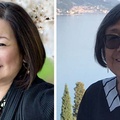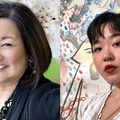One day I was walking around my house, and something stopped me. . .in fact, startled me. I suddenly noticed that I had a lot of elephants in my house…and I mean. . .a LOT.
An elephant door stopper. . .an elephant bell from Thailand…an elephant mobile . . two different elephant buddhas (Ganesha). . .I was even wearing an elephant t-shirt that day.
I began thinking back to my childhood days…and drawing. Now mind you, I never ever considered myself artistic, whatsoever, especially when it came to drawing. But, for some strange reason, the only thing I ever drew when I was younger (even into my teenage years) was. . .wait for it. . .you guessed it. . .an elephant!
Why, might you ask? I have NO earthly idea!
As I continued to reflect on all of this elephant imagery immersing me and my surroundings, I thought about Omoide, my Seattle writing group with the Japanese Cultural & Community Center of Washington (JCCCW). And I came to yet another epiphany regarding the inherent importance of the elephants in my life.
The old adage, “Elephant in the Room” comes to mind, particularly with regards to my writing. Growing up in “D-ville, USA”, I always felt that there was an “elephant” stomping around our house even though I didn’t understand what it was at the time. I could hear “the elephant”. I could feel “the elephant”. Its presence was omnipresent. But, its origins were like some big secret that the adults in the home never wanted to talk about. I now realize that the “elephant in the room” was the Japanese-American incarceration experienced by my parents, my grandparents, my aunts and my uncles.
And, like it or not, that “elephant” has continued to permeate the lives of generations that have followed. Like the elephant in the room, intergenerational trauma knows no boundaries. It seeps into our bloodlines, soaks down through our epigenetic layers, and continues to thrive deeply within the souls of the Sansei (3rd generation), Yonsei (4th generation), and even Gosei (5th generation).
Continued REpression through forced, coerced, or encouraged silence is not the answer. EXpression is the one and only way to help move trauma through one’s soul. Expression through visual art. Expression through writing – both prosaic and poetic. Expression through sounds of music.
Japanese culture has this thing about shame. Shame tends to beget silence. So it was with the incarceration experience…lots of silence…too much silence. But, why? Shouldn’t the only shame be relegated to the perpetrators for the shameless acts inflicted upon the Japanese-American incarcerees?
There is a cost-benefit to most things in life. And that includes wearing the label moniker as the “model minority”. What has been the collective cost of swallowing our pride, our pain, our past? What has this collective silence gained us as a community?
Contrary to Repressionist viewpoints, there is substantial import to “speaking our truth” – both individually and collectively. When Asians in this country are being bullied, beaten and even killed because of racist hatred and vitriole, when desperate immigrants, fleeing violence, persecution and potential death, are being separated from one another and made to live in the most unlivable conditions, when White supremacy and crazy conspiracy groups are being bolstered by far too many, has not the Japanese-American incarceration experience of the past EVER been more relevant than in the present?
In remembrance of the Issei (1st generation) and Nisei (2nd generation), whose spirits were so irretrievably tamped down, I say, enough of repression. Repression be damned. Let those “elephants” of the past trample and trumpet their travails from on high! Let our voices continue to stomp on all this hatred, fuming, festering and fouling our lives. Expression now, Expression tomorrow, Expression forever! Let us continue to walk our talk along the elephant’s path in both discovery and healing for ourselves, for our community, for a better world.
© 2021 Carolee Okamoto






